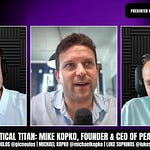New Episodes Every Wednesday @ 📺 Youtube | 🎧 Spotify | 📖 Substack
AI-first roll-ups are one of the most hotly debated trends in entrepreneurship today. The basic idea: instead of selling tech, buy the operating businesses and layer on purpose-built AI to recapture margins and outperform competition. Are these true venture bets or just PE in disguise? Are they easier or harder vs. direct software / AI?
In this week’s episode of VERTICALS, we sit down with Jeremy Yamaguchi, founder of Cabana, to unpack what it really takes to buy, build, and AI-enable legacy service businesses.
Watch until the end to learn Jeremy’s formula to running an efficient AI-first roll-up… and for a glimpse of underserved markets where the model might gain traction next.
I) This Week’s Vertical Market Pulse
AI‑First Roll‑Ups (via Euclid Insights)
Nic kicked off with an intro to the business model and few core questions. Does the model make sense economically? Is it a good use of VC dollars?Pros: bigger TAM capture (services + software), AI‑driven margin recapture, forced/accelerated adoption of AI across slow‑to‑change services, fewer tech‑native competitors (for now), and healthy capital appetite.
Cons: challenge of running 3 businesses at once (operating company, tech company, PE shop), the magnitude of AI margin uplift is still unproven, benefit of build the tech vs. be a best‑in‑class integrator is non‑obvious, the dilution math can get thorny when raise large equity checks are necessary down the road (for both the founder and for early-stage VCs).
Case studies on some of the known players:
A taxonomy of AI roll‑ups (via Matt Brown @ Matrix)
Luke shared an important view, inspired by a Matt Brown write: not all “AI roll‑ups” are the same. We discussed his three flavors:Crown Jewel: buy one large asset and AI‑enable it deeply (e.g., Metropolis acquiring SP+ to own distribution and deploy computer‑vision‑powered operations). High control, high concentration, high value capture.
Venture Roll‑Up: acquire dozens of mid‑sized assets and improve them in parallel. More integration complexity, less capital up front.
Biz‑in‑a‑Box (aka “synthetic roll‑up”): don’t buy the asset—equip operators with the full stack and participate in revenue/transactions rather than seats. Powerful in “SaaS‑graveyard” categories and health services.
GC’s AI rollup bet (via WSJ)
As in the General Catalyst example profiled in this article, big VC platforms are starting to look more like asset managers, scaling AUM prolifically and adopting what were traditionally PE strategies. We touched on the evolution of “creation funds” and studio‑style vehicles backing AI‑enabled roll‑ups. We closed the Pulse with commentary on the dilution math: whats works for founders / investors and how current funding approaches can stress the balance.
II) Vertical Titan: Jeremy Yamaguchi (Founder / CEO @ Cabana)
Cabana’s backstory: from lawns to pools. Jeremy has spent ~15 years at the intersection of home services + SaaS. After building and selling a startup in lawns, he chose pool services: small‑ticket, highly recurring, density‑driven, non‑cyclical, extremely fragmented—and no national, household-name brand.
Buy first, then build. Cabana acquires profitable pool‑service companies at reasonable multiples, integrates them into a centralized OpCo, and runs a lean HoldCo for M&A, growth, and product. They initially stayed on off‑the‑shelf tools to learn the real workflow gaps, then began building their own vertical OS where generic tools cap out at ~70–80% fit.
Capital efficiency (the HoldCo-OpCo engine). Because the acquired assets are cash‑flowing, Cabana recycles OpCo EBITDA into R&D and more M&A. Jeremy’s on‑air numbers: roughly $10M in capital raised → $12–15M revenue → >$4M EBITDA worth of assets acquired. This enables the HoldCo to run near‑breakeven while product ramps. He believes he can hit IPO scale on ~$20–30M total equity raised.
Vertical of choice matters. Homogeneous operations matter (“a pool is a pool”). Integration is often harder than acquisition. Moving teams & customers (rarely tech-forward) onto standardized processes can be rough. Jeremy seeds verticals with high SaaS friction (hard to sell software into, fragmented buyers, low ACVs, high churn) as especially attractive for buy‑and‑build.
Why not just sell the software? The pool services is extremely fragmented. Most existing SaaS is stuck targeting single‑operator “mom‑and‑pop” businesses, and therefore are not powerful or suited for multi‑market, scaled ops management. So the enterprise pool services company doesn’t really exist to sell into. Jeremy feels keeping their tech proprietary gives Cabana the leverage to pay more, deliver better service, and create a flywheel in which they’re the obvious acquirer.
The math of multiples. Multiple expansion is the name of the game in all roll-up: buy at 3–4× EBITDA and scale toward ~20× comps through growth and margin expansion. Even if public markets keep valuing you as services rather than SaaS, it can work very well, even pre-AI. There are questions, of course: underlying purchase multiples may shift and HoldCo overhead (including AI R&D) must leave room for M&A from profits rather than endless new capital (if founder / early-backer dilution is a concern).
The hardest part. You’re building three businesses in one:
An operating company (vet clinic, accounting firm, pool cleaner, etc.).
A PE shop (high‑velocity M&A machine to source, underwrite, close, integrate).
A vertical AI startup (an industry-leading applications to drive efficiency).
Memorable lines from Jeremy
“This is a venture‑style bet on the upside—with PE downside protection.”
“You’re building three businesses in one: services, M&A, and software.”
III) Vertical Playbook: AI Rollups
Why it works
TAM expansion: you capture the services dollars and the software margin.
AI margin recapture: bring model‑driven efficiency in‑house rather than letting vendors keep it.
Forced adoption: owning the P&L lets you impose change management where selling software often fails.
Arbitrage: buy at single‑digit EBITDA multiples; grow, centralize, and re‑rate to scaled comps.
Capital efficiency: recycle cash flows to fund product and M&A; raise big only for step‑function unlocks.
How to run it (Cabana‑inspired blueprint)
Pick the right vertical. High recurrence, route density, homogenous ops, fragmentation, no / weak national brands.
De‑risk M&A first. Can you consistently source off‑market assets at 2–5× EBITDA and close on founder‑friendly terms?
Stand up HoldCo-OpCo structure. Centralize finance, growth, product in HoldCo; run markets in OpCo to a common playbook.
Stress test integration. Standardizing systems, routes, pricing, and back office is incredibly hard; integration is the true bottleneck.
Build where off‑the‑shelf breaks. Ship an early wedge (e.g., CV‑driven quoting) to lift conversion now; invest in your internal OS where generic tools can’t model your workflow.
Decide your software stance. Proprietary OS can maximize value capture and M&A advantage; selling it externally can distract and compress ACVs in fragmented markets.
Plan the capital stack. Cover HoldCo burn with OpCo EBITDA; pursue large equity / debt raises only when they dramatically accelerate winning.
Founder litmus tests
Are targets similar enough that a single operating system fits?
Do market comps re‑rate with scale (key to the exit math)?
How long can the biz self‑fund HoldCo expense (minimum ~12–18 months)?
Is the vertical a SaaS graveyard (perhaps better for buy‑and‑build) or a fertile vSaaS category (perhaps better for reverse franchise or business‑in‑a‑box)?
How realistic are you on speed of integration (teams, customers, systems)?
What we debated on‑air
Venture fit & dilution math. Speed vs. ownership as you layer in $100M+ equity rounds to consolidate—whether it’s a fit for early-stage VC (targeting true top-decile early-stage VC returns) is questionable.
Build vs. integrate. When to be the best AI systems integrator vs. when to build a proprietary OS inside an operating company or rollup.
Multiple expansion mechanics. Pure PE arbitrage vs. potential technology re‑rating—and whether that even matters.
Should roll-ups be left to PE? Where HoldCo timelines, studio models, and genuine tech enablement diverge from buyout playbooks.
AI change management. Whether owning the P&L is truly the only way to overcome organizational resistance in some verticals.
Next week on Verticals
Brian Litvack (Founder / CEO @ LeagueApps) joins us to talk Hyper-SMB Strategies.
Thanks to our partner
VERTICALS is made possible by Parafin—embedded capital for your merchants. Building a vertical platform? Explore how financing can lift retention and revenue.
If you’re building in Vertical AI (or considering it) and want a sounding board, the Euclid Ventures team would love to hear from you. DM us here on Substack or ping us on LinkedIn.










